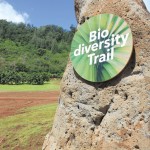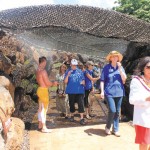Path To Preservation
National Tropical Botanical Garden is celebrating its 50th anniversary this year with the dedication of its new biodiversity trail at McBryde Garden in Lawai Valley
National Tropical Botanical Garden celebrated its 50th anniversary with approximately 450 guests last month during the dedication of its new Biodiversity Trail. Located at McBryde Garden in Lawai Valley, the 800-foot-long trail demonstrates the interconnectedness of life and is an adventure in time travel through plant history.
- The 800-foot-long Biodiversity Trail at McBryde Garden in Lawai Valley, where visitors can embark on self-guided tours
- The giant mist tunnel located at one end of the Biodiversity Trail
However, there is a light at the end of the tunnel, and it is represented by an area called “Food for Thought,” where plantings and other inspiration for a healthy ecological future inspire positive changes in biodiversity.
It’s hard to imagine that just one year ago cars were driving down this storytelling trail that now brims with plant life and hope for its future. The path was once a perimeter road for McBryde sugar plantation and was used for more than 100 years. Because of this, the task to produce a vibrant pathway from heavy, compacted clay soil was no easy feat.
“It was daunting,” says Chipper Wichman, NTBG’s chief executive officer. “But it was a dream we recognized was important to us.”
Since then, the area has transformed into a “cutting-edge display that will engage our visitors emotionally,” adds Wichman, who believes there is no better venue to discuss biodiversity issues then NTBG’s flagship garden.
The trail and its location,” he says, “represent the future and engage the public in a way that will change the world.”
The end of the trail that encourages motivation for change also contains an overlook dedicated to late U.S. Sen. Daniel Inouye, who was a major influence in NTBG receiving its Congressional Charter in the 1960s. In fact, after he was elected senator in 1964, it was the first piece of legislation he wrote and presented (signed by then-President Lyndon B. Johnson), which led to the founding of the organization. Interestingly enough, because of his busy schedule, Inouye didn’t get a chance to visit NTBG until years later, in 2006. Needless to say, he was impressed by its progress in preserving plant species since its inception decades earlier.
“The vision of our founders is truly fulfilled today,” says Wichman.
In honor of her late husband’s support of the nonprofit, Irene Inouye was an integral part of the Aug. 19 ceremony, which included the planting of a breadfruit tree as a tribute to first lady Michelle Obama (a well-known proponent of healthy living) and dedication of the Inouye Overlook.
“I know that he would be extremely pleased to be acknowledged this way,” says Mrs. Inouye, who serves as NTBG’s honorary co-chair of the national blue ribbon committee.
She jokes that she’s glad the photo of Daniel Inouye at the memorial site is one of him smiling, as opposed to his “sometimes stern look.”
“I think that it’s really indicative of how he felt when he came to the garden — one of great joy and one of opportunity to share with so many visitors the love he had for the state and the individual love he had for this island,” she says.
Inouye says she has and always will continue to think of new ways she can assist the gardens.
“It is my honor and pleasure to be a small part of this,” she says.
Wichman also is proud to be part of NTBG and is impressed with its collective accomplishments throughout the years, including the Biodiversity Trail.
When the organization was born, he says, it was “destined to have an impact on the world,” and has since grown to include five of the “most beautiful gardens you’ll see anywhere in the world.”
NTBG also is home to botanical preserves with discovery, scientific research, conservation and education programs that have had much influence on the planet and aspire to continue doing so for the next 50 years.





